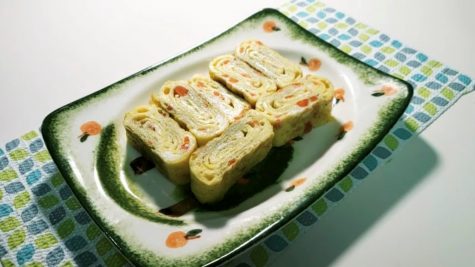Cooking in the Time of COVID: Korean egg roll
October 9, 2020
BLOGS, CULTURAL FACTS, AND CUSTOMS: Gyeran-Mari (Korean Egg Roll)

Origin:
There is no known origin for the Korean Egg Roll, or Gyeran-Mari. Literally translated to “Egg Roll,” Gyeran-Mari is conceptually basic, requiring only beaten eggs, vegetables and meat (optional). With the dish being a “rolled omelette,” finding its origin was difficult, so I tried to find the history for other omelettes as well, with similar dead ends. However, the most popular belief seems to be that the French created the concept of omelettes in the mid-16th century.
How it came to be:
A similar dish called Tamagoyaki is a sweeter, Japanese version of a Korean egg roll that also does not have a recorded origin. However, after some research, I found that it seems the dish has been in existence since the Edo period (1603-1868). Since Japan annexed South Korea in 1910 and remained a part of Japan until 1945, it might be thought the Japanese brought the concept for this dish over to South Korea, but no evidence for this theory exists. Popular as anju, food eaten with alcohol, as well as a child-favorite banchan, a small side dish, Gyeran-Mari is versatile within the Korean community. Easy to make and quite nutritious depending on how many vegetables and meats are mixed into the eggs, these simple egg rolls are quite mysterious regarding how they came to be.
Interesting Facts:
When Napoleon Bonaparte tasted his first omelette while staying at an inn with his army, he loved it so much that he asked for surplus amounts to feed his fellow soldiers.
For Japanese Tamagoyaki, the dish didn’t make its official appearance until the late 19th century, because it needed sugar to make it fluffy and soft, which was only available to the wealthy.
The Tamagoyaki, like the Korean Gyeran-Mari, became a popular bento (lunch box) side dish when prices in eggs dropped in the 1950s and the Japanese government wanted the children to intake more protein.
Recipe for Korean Egg Roll (Gyeran-Mari)
Prep Time: 5 minutes Cook Time: 5 minutes Total Time: 10 minutes
Servings: 1
Ingredients:
- 3 eggs
- 1 teaspoon of salt
- 1 teaspoon of pepper
- 1 tablespoon of butter
- 3 teaspoons of diced carrots*
Instructions:
- Dice the carrots; the size is based on preference.
- Crack the eggs into a bowl.
- Add salt and pepper to taste. I used one tablespoon for each.
- Add the diced carrots. If you have leftovers, you can use it in other dishes such as fried rice! To store it, you can wrap the bowl with a plastic wrap, put it in a container or dump it into a sandwich bag.
- Thoroughly mix all the ingredients together until they are evenly spread out.
- Heat a frying pan on medium heat, then add butter and spread it on the entire surface of the pan.
- Once the butter melts completely, lower the heat to low and add a third of the egg mixture.
- After the egg is cooked, roll the egg. Once you roll the egg, pour another third of the egg mixture and continue rolling. Repeat this process until you use up the whole mixture.
- Leave egg rolls in the frying pan and continue to flip the whole roll until slightly golden.
- Move egg rolls onto a plate and let cool before cutting them into bite size pieces, or, if you want, eat the whole thing in one gulp!

Notes:
- If you want to use other vegetables, make sure the ratio of the amount of vegetables and eggs are as follows: 1 egg:1 teaspoon of desired vegetable.
- You can add more vegetables than recommended, but the rolling process will be slightly harder.
- Doubling or tripling the ingredients is fine, but then you have two choices regarding how to prepare the food: make one giant egg roll or make several regular-sized egg rolls.
If you liked this recipe, be sure to check out this video by The Paisano’s Multimedia team.










